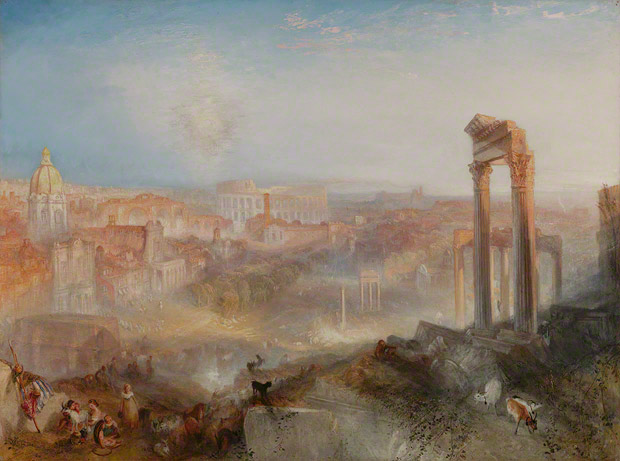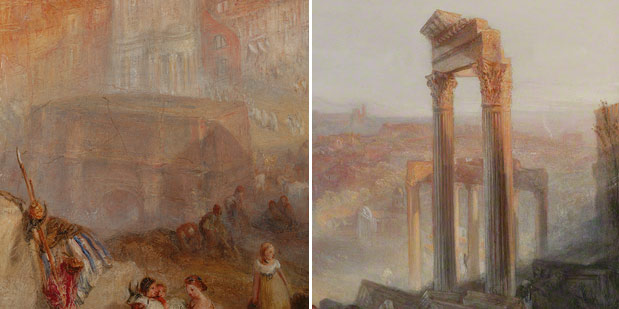Do you have memories that feel more real than your life today? British painter J. M. W. Turner did, and they are the subject of this painting.

Modern Rome–Campo Vaccino, Joseph Mallord William Turner (English, 1775–1851), 1839. Oil on canvas, 36 1/8 x 48 1/4 in. (unframed), 48 1/4 x 60 3/8 x 4 3/8 in. (framed). The J. Paul Getty Museum, 2011.6
The year is 1839. Turner, now in his 60s, has not set foot in Italy for 10 years. In his mind he journeys back to Rome, assuming a spot atop the Capitoline Hill, to create this panorama that leads our eye through a profusion of Renaissance and Baroque churches and palaces, in addition to ancient ruins.
They say “all roads lead to Rome,” and so, it seems, did the vectors of Turner’s memory, evoking in this painting a dreamlike grandeur of the Eternal City. The work is a composite of sketches, recollections, and the powerful influence of Turner’s heroes Claude Lorrain and Lord Byron. A close look reveals vivid details, such as the portrayal of figures in the shadowed foreground and the shimmering hazy light. A closer look discloses distortions, which remind us the image is a vision evoked by Turner’s memory, and that we are not actually in a real landscape. The disparity in ground level between the Arch of Severus on the left and the lofty Temple of Vespasian on the right is exaggerated for compositional effect; the Temple of Saturn is facing in the wrong direction.

Relieved of the need to be topographically correct, Turner produces sheer poetry in Technicolor. His sure technical skill and innovative brushwork provide an ethereal depiction, as the ruins and landscape dissolve into pure, dazzling color. We are mesmerized as the silvery light of the moon mixes with the golden hues of the sun.
And why Modern Rome—Campo Vaccino as a title? We see ancient Rome, once the pulsating hub of the Roman Empire, as the setting for the modern life of Turner’s day: a procession of contemporary monks gathers before the Church of Santi Luca e Martina, while peasant women with their children and goats lounge in the campo vaccino—“cow pasture”—of the foreground. The painting is a beautiful depiction of fallen greatness, full of enchantment, melancholy, rapture, and heartbreak.
Can you relate to Turner’s poetry of memory? Is there a place from your past that feels particularly vivid—so vivid you could paint it from memory? How do you see that place in your mind’s eye?
Question of the Week is a series inspired by our Masterpiece of the Week tours. Featuring an open and upbeat discussion among visitors and gallery teachers, the tours feature a new object and pose a new question each week. Turner’s Modern Rome was the object for the week of June 28, 2011.




I’ve never been to Rome, but I lived in Paris 20 years ago and now have extremely vivid memories of the sky. The blue seemed more intense and cerulean than the Los Angeles skies I was used to, the clouds lower, whiter, and more dramatic, somehow more full of personality (especially after the frequent rain). Strangely, the cityscape itself is only a blur in my mind — stained, greyish 19th-century facades. The sky of my memory is almost the opposite of the one in the Turner painting — deep and monochrome, with dramatic 3-D clouds everywhere. I don’t know if I ever actually saw a sky like that in Paris, but that’s how the city lodged in my mind’s eye.
That’s interesting, my memories are of Paris as well. I’ve only been there once, and I keep thinking of my last full day there, when my roommate and I split up and I wandered the city alone. She didn’t want to do churches, so I went to the Madeline, Notre Dame, and Ste. Chappelle. I still have this sense of feeling dwarfed by the columns and roofline of the Madeline contrasted with the bright blue sky that Anna wrote of. The shimmering light and sense of being in a jewelbox in Ste. Chappelle, something that I’d longed to see since my frosh year of college. I distinctly remember trying to burn the memories of walking along the Seine or the park at Versailles into my head. I think it’s about the only city I’ve visited that has left me with slackjawed reactions to so many of the monuments and the beautiful architecture.
La Bufadora, Ensenada, B.C., Mexico I never been anywhere outside North America. But the house we rented in Ensenada and the view of the city and the bay at night. The fishing boats and the lights behind the mountains. The fog rolling in, playing with Sage out in the yard. Thats the place for me.
Hello Anna, bmw, and Jesus,
Thank you for your wonderful comments. How interesting that all three of you mentioned light and atmosphere as such a significant element from a special place in your past. Just like in the painting, through your writing, I feel transported to the Paris and Ensenada of your vivid memories.
This post and the various responses speak to the idea that places have memory and in turn create memories for those who visit them. And certainly Paris and Rome have centuries of memories! And the coast of Ensenada ebs and flows with memory. Christine, I love your thought that an artist can be free from constraint, in Turner’s case the constraints of topography. What a great theme to consider when looking at art: what has the artist overcome to create this work of art.
While Turner’s painting of the Eternal City does read true from how I remember it, my last trip there gave me one of my fondest memories. Driving early in the morning to visit the Borghese Gallery, a large man on a scooter drove up next to me and shouted, “Ti senti bene?!?” (Are you feeling ok?) evidently my driving was more crazy than his fellow Romans’. I still remember the warm air, the bright hazy light, and the combined smell of the rental car, hand cream, coffee, and wet earth. Thank you for a wonderful post down memory lane…
After a clear, warm day at Stinson Beach in Marin County California, we began the long drive home along US Highway 1, a beautiful, scenic route along the California coast. As we drove along, a dense fog began rolling in like a flood of water, over hills covered with heather. It was a remarkable site, both beautiful and strangely mysterious at the same time. The conditions were unusual and I has never seen them quite like that before or since. On the right was a dense fog and before us and on the left fog spilling onto the road and the heather … the warm inland meeting the advancing, cold fog. It lives in my memory as if it happened yesterday and just thinking about it seems to console me in difficult times.
Yes, I have recently been inspired to paint from memories. I am an artist in Newport Beach, California and I was born in Minneapolis, Minnesota. Memories of my youth spent near a lake named Lake Harriet became so vivid that I decided to try and paint it. The painting is impressionist in style with blues of the lake and sky in the particular light I remembered. I also included the trees near the lake and one in particular that my high school friends and I would go to for long talks on summer days. I was surprised how much the painting captures deep feelings for me and looks like the real place. It was a thrilling experience.
Bryan – the scent of earth! Yes! I spent 14 years of my life working at Disneyland, and there are some specific memories there as well. I always loved the park first thing in the morning long before the guests were admitted. There is sometimes mist rising off the Rivers of America, and without all the popcorn and churro carts open, the scent of earth and whatever flowers are in bloom at the time is much more apparent. One can hear the sound of Snow White’s voice echoing off the castle wall, plus the various echos of calls over p.a. systems as the rides are powering up and you hear the voices saying “remain clear of all drives, belts, lifts and vehicles.” There is a certain pitch of a whistle that I can hear from the train station near my home, and it’s the exact pitch of the Mark Twain riverboat. It’s like I never left the park. I don’t even have to close my eyes – I know the feeling of all different areas of rides I trained on, the sounds of music in different areas, backstage sights like the pony farm and other things we’re never allowed to mention publicly. You knew when in the morning you’d have to ramp up your energy because tour groups from certain places would be coming to your location at exactly 10:30, or start preparing for evacuations because at a certain time of year and day, the sunlight would hit a certain spacing sensor on Big Thunder and the computer would automatically shut the ride down. I haven’t worked on Storybook Land since 1993 and I can still do the spiel word for word. When I think of the park, I don’t think of the masses of people the way it can be on a typical summer day – I think of off hours in the berm with my colleagues, images of details that one doesn’t normally get to take in because of the crowds, and it’s through a hazy prism much like Turner’s image of Rome. Maybe I need to start playing with some digital imaging to match my memories – thanks for the idea, Margie!
Hi Bryan, Margie, Carol and bmw,
What prompts our memories is so curious. You can see that we’ve had quite a lot of comments about fog, atmosphere and the sea–all conjuring up great images.
One visitor exclaimed how she thought the work reminded her of Salvador Dali. At first I thought to myself, WHAT? HOW? It turns out she was referring to Dali’s painting with the melting clocks, the hazy bluish sky, and the fetus-like fish head washed ashore. Unbeknown to that visitor, the title of that work is ‘The Persistence of Memory’ (1931). Dali was supposedly inspired by his own dreams, nightmarish ones, at that, with swarming ants. Memory is the impetus to both these works of art – how great that our visitor made the connection intuitively!
I love the Disneyland story, bmw! When you mentioned “the exact pitch of the Mark Twain riverboat,” it tooted immediately in my mind. Disneyland has a heightened, over-the-top quality — surreal, even? — with unusual sounds and smells that make it intensely memorable. I wonder what Dali would have done with it.